The cultural construction of gender has been developed in different ways throughout history, and although all societies have gender cultural registries, not all of them have the concept of masculinity. A culture which does not treat women and men as bearers of polarised character types will hardly have a concept of masculinity in the sense it has in the modern western culture. However, the globalisation in which we currently live presents us with a model of masculinity which is universal, dominant and patriarchal. In this article, we will attempt to elucidate how this imaginary was originated, aiming at understanding how it evolved to our current reality.
The construction of the concept masculinity has followed different processes, but nowadays it is associated with a series of social rules widely generalised: avoiding femininity; restricting emotions; chasing accomplishments and status; disconnecting sex from intimacy; performing aggressiveness, homophobia, etc. Man, as an identity, is constructed essentially on a relational basis, as opposed to the values attributed to the identity woman. In this binary logic, the male value is always placed in front and holds a positive value, conferring a negative value to its female opposite: strong-weak, brave-cowardly, rational-emotional, social-natural, productive-reproductive, shape-matter, public-private, active-passive, dominant-submissive, abuser-victim, etc.
We can also see how the concept of masculinity intersects not only with gender oppressions, but also with other oppressions such as race, class, age, etc. The “white male” has not been constructed only in relation to the “white woman”, but also in relation to the “black man”. By the same token, the effect the “rich man” or the “erudite man” have had on the development of masculinity has been different from that the “poor man” or the “illiterate man” have had. The “adult man” has also an identity which is differentiated from that of the “boy”, the “young man” or the “old man”. That is why an analysis with an intersectional perspective can help achieve a better understanding of this process. However, the element which most strongly conditions the conception of masculinity is, undoubtedly, the construction of the identities man-woman.
Gender roles are perceived as a hegemonic reality in contemporary societies. Despite the academic development of theories which question the division man-woman, and which are growing to find more and more support in biologic and sociological studies, those are theories which have a limited practical incidence beyond universities and small bubbles. It seems like analysing masculinity from the optics of queer theory does not help understand how it was originated, since those postmodern theories need of the man and woman subjects, built through history, to be postulated as antithesis. In order to understand how the meaning of masculinity has been configurated, it is important to look back to the river of human history.
SOURCE: THE INTERNATIONALIST COMMUNE OF ROJAVA




